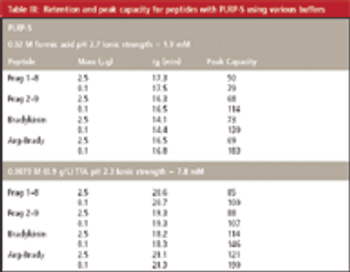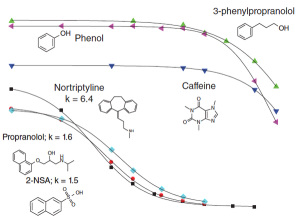
In this third part in the series, we discuss chemical causes of peak asymmetry, including effects from mass overload and slow desorption kinetics.

In this third part in the series, we discuss chemical causes of peak asymmetry, including effects from mass overload and slow desorption kinetics.

What leads to an asymmetric peak shape? Physiochemical phenomena can help chromatographers identify whether the cause of asymmetry has a chemical or physical origin.

This review addresses recent ideas on the separation mechanism of HILIC, the advantages and disadvantages of the technique, and new applications.

This article is an update on the technique of HILIC and covers recent ideas on the mechanism of separation, and how it may be manipulated to suit the separation of particular sample types. The advantages of HILIC are discussed, and also the actual and perceived disadvantages of the technique and how the latter can be overcome. Some new applications of HILIC for characterization of biopharmaceuticals, where it can even be applied to the separation of intact proteins, and to applications in metabolomics, will be discussed.

Peter Myers on the past, present, and future of stationary phases

This article details the principles of hydrophilic interaction chromatography (HILIC) and its complementary selectivity to reversed-phase high performance liquid chromatography (HPLC). Advantages of the technique that result from the use of low-viscosity, high-organic concentration mobile phases will be demonstrated. For example, LC–mass spectrometry (MS) sensitivity is enhanced and higher flow rates and longer columns can be used effectively with such mobile phases in HILIC. Common stationary phases employed in HILIC are reviewed.

This article examines the results of chromatographic performance when using different buffers. A study of the origins of the differences in peak shape obtained when using varying buffers–additives is presented with regard to the analysis of basic peptides in reversed-phase HPLC.

Formic acid often is used for the analysis of peptides in proteomic studies by HPLC-MS, due to its volatility and reduced signal suppression. However, poorer chromatographic performance can be obtained in comparison with trifluoroacetic acid or nonvolatile phosphate buffers due to increased overloading, which can occur even for extremely small sample masses. Comparison of a highly inert silica-ODS and a wholly polymeric phase indicated that overloading effects on both are very similar and caused by the mutual repulsion of solute ions on the hydrophobic column surface.

Published: November 1st 2021 | Updated:

Published: December 1st 2021 | Updated:

Published: April 1st 2008 | Updated:

Published: May 1st 2005 | Updated:

Published: February 1st 2005 | Updated:

Published: February 1st 2017 | Updated: